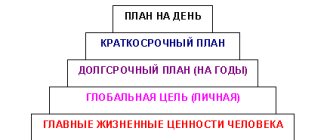To define and create a life plan, you need a pragmatic and concrete method that opens the way to planning and action. Because where most personal development methods are full of wonderful words and intentions, they are missing the crucial element of achieving your ideal life as quickly as possible. And the main mistake, as a rule, is that the life plan drawn up is too idealistic, too utopian and too ambitious.
Having a vision for your life, knowing how to extract its essence, formulate it as a life project, is essential for a successful life.
Why do you need a life plan?
Do you feel like you're not moving forward in your personal or professional life and aren't sure you've found what makes you happy? If you're tired of letting yourself flow without knowing where you're going, take a break from your crazy race that's getting you nowhere. Take a few minutes to think about creating a blueprint for your life. This is a great way to make sense of your life by giving it direction.
Keep in mind that once a life plan is determined, immediately after it is developed, steps must be taken to implement it.
“If you don't know where you're going in your life, you're leaving your gifts, your talent, the happiest hours and the happiest days of your life to chance.”
— Robin Sharma
Why do you need a text outline?
Think back to your school days and planning assignments. Most of us thought: why are they needed at all? As a result, not everyone was able to produce structured and competent essays: numerous repetitions, logical inconsistencies and other flaws killed the impression of what were, in general, good and, most importantly, independently written works.
Of course, while studying, you can “rip” anything from the Internet: even a plan, even an entire essay. But in adult life, this will result in outright helplessness in the face of the need to clearly and cogently express thoughts not only in a public speech or a commissioned article, but also in ordinary everyday conversation.
There is nothing to do in web writing without the ability to present information consistently and without repetition. Fortunately, this skill develops at any age, albeit at an individual speed. But over time, a quick reading of the material will be enough for you - and the outline of the plan for the future text will already be drawn in your mind.
This skill is necessary to reach a qualitatively new level of payment: it is no secret that writers who do not want to develop sit all the time on 20-50 ruble orders, and their opuses resemble a kind of vinaigrette of words and thoughts. The inability to work with information (search, analyze, present logically) is the first sign of a random person in copywriting. Either improve yourself, or look for another path - there is no third option if you do not want to consider yourself an outsider.
The earnings of top copywriters amount to thousands, and sometimes tens of thousands of rubles per text. And they, too, were not born with the ability to write effective commercial and useful informational texts. Yes, a lot depends on your abilities, but the main component of success is daily work and self-improvement.
Make sure you need a life plan
Regardless of whether you are satisfied with the path in life you have already taken, know that in order to achieve success in the future, the components and strategies that contributed to your success will not be the same.
It is important to be aware of this and determine the next stages of your life as quickly as possible. What will be the main projects that you are ready to undertake: a new professional opportunity, relocation, business, starting a family, etc.
Building your plan gives you the promise that beyond the vision, you will take action to achieve your goals. If you're just looking for a feel-good read about personal development without making the slightest impact on your life, there's no point in reading further.
This is a practical and concrete method for ending procrastination. So grab some paper and pencil and get started now.
So if you're not ready to grab paper and pencil now (or at least take notes on your phone), you're missing out on a rare opportunity to take control of your life.
You must be sure that if you are in need and suffering today, or even if you are already benefiting from exceptional resources without having a vision for your life, you are on an uncertain life trajectory that is leading nowhere.
Take control of your destiny by defining a vision for your life and then planning steps to move forward.
Before you start, you need to make sure you need a vision for your life because:
- if you don't change anything, you will end up not being completely satisfied with your life;
- A better life can be achieved when we give ourselves the means.
Drawing up a plan depending on your goals
Each type of article requires a special approach to creating a plan, although the principles remain identical: strict logic, consistency and user clarity. Let's look at the types of articles that are most often ordered for websites:
- Information article . We will need a strict structure and sequence, with little introduction and conclusion. If a digression is necessary to understand the topic, you need to organically formulate it as a separate paragraph and provide for it in the plan.
- Instructions . The instructions describe step by step the actions necessary to achieve a goal. Therefore, a thesis plan is ideal here. Perhaps even simple, if the branching of the algorithm is not provided for (under one condition we do this, under another – differently).
- Commercial text . Everything is more complicated here: writing effective text that helps increase conversion (converting users into buyers, customers, subscribers - depending on the goals) is aerobatics. There are special formulas for the structures of selling texts: the old but still effective AIDA and its young “competitors” such as AIDCA, PMHS, ACCA and others like them. Here you first need to decide on a formula, and then use it to create a plan and write a text.
- News . News articles are usually small, but a plan is still needed, because in this modest volume you have to fit a maximum of information in a compressed form, without water. Don’t forget about an effective and informative introduction, which is written according to the formula “What? Where? When?".
- Blog article . Great freedom is allowed here: the names of plan items and, accordingly, headings can be not so much informative as creative. A little confusion will also not cause rejection - this is a blog, written from the heart. Particular freedom is allowed if the blog already has an established audience and the author’s name is well known in certain circles.
How to leave a life plan in 7 steps
First of all, you need peace of mind to determine your life plan. Sit in a quiet and inspiring place where you will not be disturbed for at least two hours. Turn off all notifications on your phone.
If you are not willing to spend two or three hours and or dedicate several hours to give meaning or direction to your life, then you will not be among the 5% of people on Earth who succeed in life.
“Tomorrow belongs to the people who prepare for it today.”
— Malcolm X
If you are tired of living automatically and want to manage your life, set goals and achieve them, you have every chance to succeed. So, let's begin.
Plan analysis
The next point you need to dwell on in order to figure out how to make a text outline are examples of the most common mistakes that students make. Be sure to review your work. What should you pay attention to?
- Information content. The points should not be too general (for example, simply “The Ugly Duckling” will not tell you anything).
- Length. Descriptions should not be too detailed - the outline should only mention those details that are necessary to understand the themes, ideas and logic of the text.
- Proportionality. It is desirable that the points are the same. Too short ones should be removed or combined with longer ones.
- Structure. The plan must have an introduction and conclusion.
- Subsequence. Each point should logically follow from the previous one.
- Formulations. They should not be repeated or overlap in content with neighboring theses.
- Logics. It is important that your plan gives an idea of the cause-and-effect and other connections between the blocks (“Because... happened..., which led to...”).
The best test is to let the plan “rest” for a couple of days (or at least hours), and then, using only it, try to retell the text as close to the original as possible.
Brainstorm
Take a pen and paper and write down all the ideas that come to your mind. You can carry this list with you everywhere to capture ideas that may come up throughout the day or week.
It may be helpful to give yourself a few days to think about it. If you can't find inspiration, do this: mentally transport yourself 3, 10 or even 20 years into the future. Imagine what your perfect day, your perfect week, your year filled with happiness will be like.
You can also delve into your past (childhood, adolescence), focusing on moments in your life when you were very happy. Look for what made you happy in the experience. Was this possession something? Was it a group of friends? Was it in contact with nature? Continue on this path to find what makes you truly happy, forgetting for a while the standards set by society.
Close your eyes and immerse yourself in these moments using your 5 senses: sight, smell, taste, hearing and touch.
At this stage you define the vision. It should be clear in general terms, but not necessarily precise. If you enter elements that are too precise, you will limit your options and miss out on great opportunities.
Don't limit yourself, think geographically on a global scale, think as if you have no limits.
How to make a rough plan
It is convenient to draw up draft plans for the future in electronic format. It’s a hassle on paper; you’ll need to constantly edit the list of goals. I made over 50 edits to the last plan.
For clarity, we break down our goals into areas of life, like in the wheel of life. We write down all the goals that come to mind for each source.
Use the templates:
Template with goals: open, , Google.docs, Evernote.
Life planning template: open, Google.docs, Evernote.
We take each source of goals, come up with and write goals based on it, without much analysis. First, let's just put everything together. There is a personal meaning to life - we wrote down goals to realize it. There is a purpose - they wrote it out. Old dreams are written out. We did the 100 desires exercise and wrote down the 10–15 most burning ones. We imagine ourselves in 10 years, where and with whom – we write it out.
We make a plan for the year - write down all the goals.
I draft it in a week. I spend three more weeks editing, agreeing on goals, and adjusting it to reality. I have all my goals and long-term plans written down in a notebook, more than 30 pages of different wants and dreams. I leaf through it and write down what I would like to implement now, repeat 4-5 times.
Within each sphere, create 3-4 goals. We leave only the most want-to-can-do, mentally imagine how you will fulfill the goal, if you don’t imagine it, cross it out.
I recommend creating a backup plan: moving there all the goals that do not fit into the annual plan. When you manage and have nothing to do, the goals are already ready.
If you are making a plan for the first time, it is better to plan simpler goals and 2-3 goals at a time. If you dream of running a marathon, set a goal of running 5 km to start. You will have time to complicate the goal. Initially, everyone overestimates their abilities. If after six months you close the plan, make a plan for the remaining year, with the joyful feeling that everything you planned has worked out.
Future plans should take into account your experience.
If you look at the draft and anxiety appears, “How will I manage to do all this?” – lighten it up so it’s rich but not overwhelming. The more experienced you are, the more you will plan your own way.
Avoid classic mistakes
Here are some classic examples of mistakes you can make when you start planning your life. In most cases, a simple, more general formulation will suffice.
Classic mistake #1
Your vision is to live in a specific place, say on that island paradise you once went on vacation to. This is good, but too restrictive. In this case, you need to go deep into your mind to understand the original reasons for such a desire. Do you need the sun, the beach, nature, human friendliness, a festive atmosphere?
A better wording might be something like this: “I want to live near the water in a region where the weather is good all year round.” So, instead of settling down on an island paradise in the Bahamas, you will positively evaluate your professional opportunity in Hawaii.
Classic mistake #2
The desire to work in a specific company, to make it the ultimate goal of your professional career. Again, this is too restrictive. Rather, you need to take inventory of what you like about the business and then summarize. Additionally, while some companies may be viewed as very attractive from the outside, professional life on the inside can be frustrating.
Moreover, building your entire life around one business is dangerous. If you gain access to that company but one day lose your job, or if a conflict with your boss causes the atmosphere to become untenable, you risk putting yourself at risk entirely.
Whereas if your life plan states your career aspirations in more general terms, you are spoiled for choice to switch to other experiences that fit your life plan.
Classic mistake #3
You write a life plan to impress others. Lifestyle, material wealth, position in the company, social status... Is this really important to you? Or are you doing all this to impress someone? Perhaps you are doing this because your family strongly suggested it to you? Or because you want a bigger house than your neighbors, a cooler car than your friend?
You have to ask yourself: If all these people disappeared, would your goals still be as important? Check each element of your vision for life - it's what you want, not someone else wanting it for you. That you want to change your life not for the sake of others, trying to look your best for them.
So, take all the elements of your life project to either generalize them (open up new horizons) or eliminate them (after all, deep down you don't really need them). This simple check will allow you to:
- increase the likelihood of success because the field of possibilities is expanded;
- reduce the time to achieve your ideal in life, because you will take away everything superficial, everything that would force you to waste a lot of time, energy and money.
How to make a final life plan for the year
In the list, we place the spheres themselves so that the more in demand is higher. Ideally, one aspect of life is to prioritize the year in which we want to achieve a breakthrough. Usually, this is the area that worries us most and ruins our lives. It is desirable that the remaining goals work for the main sphere or at least do not interfere.
For me this year, the main thing is to move forward in the “Career” direction - I’m moving it up. I read books for knowledge on the project. Into the rocking chair for energy. Experiments for articles. Everything in general is for happiness.
Sausage is the main thing
For a beginner, the main goal of drawing up a plan is to gain planning experience, complete it 100%, deservedly be happy for yourself and feel growth above the circumstances.
The plan for the year should be flexible: there was no such thing that I did not complete 15–20 goals. We leave room for something new by 25%, this is every fourth goal. Usually, I keep some of my goals in a separate list, outside the plan. When I redo everything, I add them.
Open my final plan.
I write down a list of plans for my life in a notebook.
On sheet A4 I draw a map of goals.
Write your life vision
Your initial sheet of paper should be covered all over. Take a new piece of paper, a computer file, or your journal and write down an outline of your life vision. Summarize in 3-5 sentences.
Example of a life project:
So that my children have a good education and live in a developed country, away from big cities, away from pollution, in a socially beneficial area.
Constantly improve your skills and gradually switch to working from home.
Live in the mountains in winter and in a tropical country in summer.
Throughout my life, to be able to travel frequently and comfortably.
This example specifies inaccurate geographic locations and does not mention physical goods. This life project, as formulated, has the advantage that it is very flexible and has a high probability of becoming possible.
In any case, as you reach maturity and self-awareness, your vision will develop and gain clarity. If you're single now, expect profound changes in your outlook on life when you have a partner.
But the most important thing is that whatever path you take in your life, you do not compromise your values or deep aspirations in your vision for life.
The road to success is not always straight. Sometimes you need to know how to take a detour to get to your destination faster. If today, despite this method, you are struggling to clearly define your life plan, you should not jump to the conclusion that this method is not suitable.
Maybe you're not relaxed enough. If you are young, perhaps you are not mature enough, you have not had enough experience to know yourself. Maybe you haven't had strong enough experiences to understand what happiness is. In this case, bookmark this article so it's easy to find, and resume this exercise in a few months: during your next vacation away from home, for example.
Assess the required resources
Let's get down to business. Great intentions and dreams are good, but to flesh out and fully live this life project, you will need resources.
When it comes to money, we strive to finance life, and it is on this scale that financial goals should be set:
- Durable goods that do not depreciate in value and, once purchased, can be used for life (real estate, land, boat). But be careful, after purchasing them you have to think about the costs of maintenance, maintenance and storage, periodic repairs, energy consumption, insurance, maintenance, taxes. These costs must be properly estimated so that they are adequately covered by cash flow.
- Consumer goods that need to be updated regularly: subscriptions, services, car, household appliances, furniture.
- Daily budget and leisure: food, fuel, services, subscriptions and more.
When you estimate the money you will need to finance a life project, you should classify it into two categories:
- Capital: This is the price one has to pay to buy assets and durable goods.
- Cash Flow: Monthly budget will fund your lifestyle, daily and leisure budget, renewal of durable goods.
Find your way
Now you know what you want: you have a vision for life. It will develop over time. If you've already had a lot of experience and know yourself well, your vision shouldn't change radically. You need to strategize and plan to get there. And, above all, provide financing.
Just like a vision, your life plan will not be fixed. It will constantly evolve according to the opportunities and obstacles you encounter. Because life is full of uncertainty and filled with surprises, you must always remain flexible.
So now take another piece of paper or a computer file like Excel. Spend an hour, or several days if necessary, writing down all the ideas that come to your mind to achieve your desired goal.
Now the financial elements should come into play in your plan. Money will allow you to achieve your ideal, your freedom. Don't forget about the financial aspects of your life plan.
- How to Create an Action Plan and Achieve Your Personal Goals
Don't stop brainstorming until you have at least 20 different ways to achieve your goal. If you need inspiration, go for a walk in nature. Don't write immoral, illegal, luck-based things on your list, such as winning at a casino, robbing a bank, waiting for an inheritance, suing someone, etc.
Useful tips
Now that you know how to plan a text in the Russian language, it’s time to talk about little tricks that will help you complete the task faster and better.
- To highlight semantic blocks, focus on paragraphs - as a rule, each contains one complete thought.
- Highlight the bright images that were most memorable and try to use them in headlines.
- Work on the design. For main paragraphs, simple numbering is usually used (1, 2, 3), and for subparagraphs, double numbering (1.1, 1.2, 1.3) or letters (a, b, c) is used.
- If you can’t come up with a title, look at what words/terms are used most often in this fragment and go from there.
- A draft plan should be sketched out already during the first reading, when you follow the author’s thoughts more carefully and notice the boundaries of thoughts.
Remember that a lot depends on what you are writing the plan for. On the test, you can simply list the main topics that are revealed in the text. But if you are doing this for yourself, in order to better assimilate and remember the material, it is better not to be lazy and make a complex plan, noting important details.
Best idea so far
The main principle of this life planning method is to always work on the best idea at the moment. This will allow you to gain skills and, above all, to be on the move to discover new opportunities. Stillness gets you nowhere.
Put yourself into action on the best plan you have today until a better idea presents itself to you. The world is full of riches and available opportunities for those who try to explore them.
To explore, you have to be on the move. It is by constantly trying new possibilities that we find our way. And once you find it, learn it thoroughly and become one of the best in your field to create maximum value in minimum time.
Now that you have this long list of possibilities, add the following columns:
- Implementation efforts;
- Skills to be acquired;
- The total time required to achieve the goal;
- Probability of success.
Now that you have evaluated all your ideas, rank them from most significant to least significant.
Take the first three ideas and analyze their likelihood of success in more detail. From these three ideas, choose the best one and start working on it carefully until it produces results.
Then just move on to the second idea. The magic is that if your first list of ideas took a long time to develop, once you start promoting the idea, many more ideas will sprout within you and many opportunities will appear out of nowhere.
Focus on your first best idea and write down any new ideas on your list—they'll come in handy later.
Basic forms and purposes
Work on the plan begins with a careful reading of the information: you need to understand it properly, highlight the main topic and idea. Let’s first work on a ready-made and well-known text - the fairy tale “Ryaba Hen”. So, the topic: how the golden egg broke. The idea: there is no need to be sad - whatever happens, everything is for the better.
Next, you should break the text into main parts and label each of them in some way. The main thing is that, having this plan in front of your eyes, you can retell the basic information orally or in writing (why not prepare for rewriting?).
But how you will mark parts of the text is up to you, but the shape of the plan that will turn out in the end depends on this.
Abstract
If you want to create a fairly detailed plan, go with the thesis version. Each point is a phrase containing a complete thought characterizing a passage of text. Let's take our example:
- The hen laid a golden egg.
- The old people couldn't break the egg.
- The mouse broke the egg with its tail.
- Grandfather and grandmother were upset.
- The hen promised to lay another egg.
Before us is a well-known fairy tale, presented in the form of main theses. Please note that each point is an independent narrative sentence. According to this plan, it is easy to rewrite (retell the main content) logically, completely, while maintaining the structure.
Outline
Here we will step away from Ryaba’s chicken for a moment, because the outline is drawn up only for large-format texts, so a short fairy tale for kids is not suitable as an example.
The outline is an evolution of the thesis, more detailed and expanded. Plan items can be entire blocks of information in the form of paragraphs. In copywriting, this option is used extremely rarely, except perhaps to bring order and awareness to an unfamiliar topic or to adapt it to the needs of the target audience.
For example, we have a detailed article on the allocation of a share of an inheritance, written by a practicing lawyer for colleagues. It is clear that it is difficult to understand the special vocabulary and terminology without a legal education, to put it mildly. Our task is to understand what the lawyer is writing about, shorten the material somewhat and bring it into a form understandable to the target audience. For this, drawing up an outline with a reasonable replacement of special terms with commonly used ones is ideal. In a word, from a purely special article it turns into a popular one, intended for a wide range of readers.
By the way, the ability to create an outline will also be useful for students who actually record lectures. The art of shorthand has died out due to lack of demand (the teacher’s voice can be recorded on a dictaphone), but for many it is easier to assimilate and remember information by writing it down in the old-fashioned way, with a pen in a note.
Interrogative
A plan formed from thematic questions to parts of the text is called interrogative. However, experts more often call it interrogative, which is logically more correct. So, we simply formulate the questions and write them down in order.
Let's return to the long-suffering chicken Ryaba. So:
- What did the chicken Ryaba do?
- What did the old people do with the golden egg?
- Why did the egg break?
- How did the grandfather and grandmother react to this?
- How did the chicken console the old people?
While writing the text, you will have to answer questions, so you need to formulate them as specifically as possible so that a detailed answer automatically appears in your head.
This type of outline is ideal for preparing a detailed oral response or writing an exposition. Let’s apply this option in web writing: you analyze layers of information, formulate plan points in the form of questions, and write text in the form of answers to them. By the way, this option is very convenient for writing large articles: you can always expand the answer as much as possible, add your own thoughts or interesting useful information. Conversely, you can shorten your answer if you see that you are catastrophically going beyond the established volume limits.
Quotable
The content of this type of plan is determined by its name: it consists of quotations, that is, verbatim excerpts from the original source. I won’t give his example for reasons of uniqueness: any quote reduces this indicator, which is not very good for promotion. But when writing a school essay, this, on the contrary, is welcomed: it demonstrates the ability to navigate the text.
Compiling a “quotation book” is one of the most common tasks in Russian literature, starting from elementary school. There is no need to invent anything here: find a suitable phrase that expresses the idea of part of the text, write it down without changes - and well done.
Quotations from already written texts are often used when preparing reports, defending theses and abstracts, as well as other types of oral presentations. There, verbatim quotes are appropriate and only increase the credibility of the speaker.
Nominative
This type of plan requires the need to come up with names for each logical part, that is, to name it. The title plan is minimally informative compared to previous options and serves, rather, for “representative” purposes. It is problematic to retell the text based on it, but from it you can form the names of sections and points of the narrative.
Pay attention to the beginning of this publication: the title plan of the current article is presented there. It’s convenient to navigate through a decent amount of information, right? I drew up a plan for this text before starting work, but as I wrote it I made some adjustments and added new points. It happens that worthwhile thoughts come in the course of work - shouldn’t you refuse them if they will be useful to readers?
And the last mention of the chicken Ryaba in terms of names:
- Golden egg
- Actions of the grandfather and woman
- Mouse and golden egg
- Tragedy
- Consolation of the elderly
Of course, when applied to a fairy tale for children, such names sound somewhat pretentious and comical, but I hope the example will be clear to everyone. And a good mood has never hurt anyone!
Support
We have before us the last type of plan - the support one. There are no requirements for it, since it serves solely to systematize the material and facilitate subsequent reproduction of information. The main criterion is ease of use. Paragraphs may differ significantly from each other in structure and length. They can be individual words, quotes, phrases, and so on.
Basic outlines are often used when preparing oral presentations. For example, in most cases they are made up of students taking exams in oral disciplines: draw out a ticket, during preparation, sketch out a supporting plan - and use it during the answer.
Many writers also use reference outlines, jotting down ideas that come to mind in a notepad or smartphone. You never know when it will strike you: while jogging in the morning or preparing/eating lunch.
How to implement a life plan
Now that you have identified the best idea so far, transform that idea into an action plan in several steps, ideally 2 to 4.
The minimum duration of each stage must be one year. At each stage, break your plan into smaller intermediate periods: 3, 4, 6 months.
Frame each major step and each intermediate step as a goal to be achieved. Then break the first step down into weeks. Every week his goal must be achieved.
There is no need to waste time planning the next steps until you have taken the first one. Because not everything will go according to plan. At first, you will fall into the classic beginner trap: you will underestimate the time and effort required. For example, as part of starting a business, you will overestimate financial income.
Basic principles of life planning
At the first stage, we make a draft list of goals. It’s convenient to start collecting goals and taking a closer look at them in December. You can test them to see if they suit you; if it’s vocals, go for a trial lesson.
But even before starting to draw up a plan, it is useful to accept the principles so that moving according to the plan will be a joy:
- The rocking principle: “No pain, no growth.” Controlled stress makes us stronger. It pays to work hard this year, knowing that next year we will get additional opportunities.
- Life is long. A goal achieved with pleasure in a month is better than grinding your teeth in 2 weeks. You should take it at a calm pace, not a sprint. It is more effective to set “pace” goals rather than overachievement goals.
- Constant growth. Most of my life is filled with people, ideas, work that were not even in my dreams 5 years ago. I dreamed at the beginning of the year, got excited, and by the end I was surprised.
- No extra effort. I am against hellish achievements, I am for habit and system. Running 5 km every day is easier than running a half marathon every 4 days.
The more experience you have in managing personal projects, the more accurate your planning will be.
Having a life vision, represented by a life project and implemented by a life plan, is the best way to move forward and ensure success.
Achieving your ideal life will take several years. If you think that you can achieve your ideal in less than a year without doing anything, it is because you are underestimating the effort, or you are not far-sighted.
There is no quick method. Making a life plan means articulating what you want. This makes it easier to make a decision when the opportunity arises. You can easily evaluate it by asking yourself the question: is this opportunity, this decision, this action taking me closer or further away from my ideal life?
- How to Write a Personal Development Plan
- Good habit: plan your day
Definition
The plan is a list of main thoughts that reveal the content of the text, the sequence of facts and the logical connections between them. Simply put, these are short notes, by looking at which you can easily recall the text in your memory, and ideally, retell it without confusing anything. The plan is often called the “skeleton” of the work - what remains if all unnecessary details, details and artistic techniques are removed.









